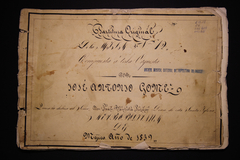RISM Modern Monday: Mexican Music
John G. Lazos
Monday, January 25, 2016

Our third entry in our RISM Modern Monday series is by John G. Lazos, who contributes Mexican sources to RISM (Spanish follows):
Mexican music is generally recognized as the music from the first decades of the twentieth century, a perception which was influenced by a twentieth-century Mexican cultural national ideology. The main premise was to combine the classical forms of music with pre-Columbian sounds and instrumental content. The composers who best exemplify this approach are Manuel M. Ponce (1886-1948), Silvestre Revueltas (1899-1940), and Carlos Chávez (1899-1978) and it is the latter’s Sinfonia India that is the most emblematic composition from this period. The sounds of this music have become identified with Mexican music.
By contrast, the music that originated from the period of Mexico’s independence in the nineteenth century is characterized by the transitional sounds of sacred music traditions and its mixing with those of the burgeoning secular milieu. This period of music to date lacks study, and as a result continues to be alien to our ears. The music of the Mexico’s nineteenth century brought together the formal characteristics of liturgical music that came out of three centuries of ecclesiastical music practice from the period of New Spain, and the content related to secular music, such as the important and influential presence of Italian bel canto opera. The composer José Antonio Gómez y Olguín (1805-1876), who wrote over 140 works, is one of the most representative music figures of his time.
In the late twentieth century and these early decades of this century, Mexico has seen a vast number of composers and performers, many of them who have studied and worked abroad, continue to redefine the musical idea of Mexican music through a variety of traditional and contemporary techniques.
This sums up the present music in Mexico.
Música Mexicana
Música Mexicana es generalmente reconocida por el periodo que comienza durante las primeras décadas del siglo XX. Ella es resultado de la ideología denominada como nacionalismo, y cuya premisa fue conjuntar las formas clásicas con los contenidos sonoros e instrumentales precolombinos. Manuel M. Ponce (1886-1948), Silvestre Revueltas (1899-1940), y Carlos Chávez (1899-1978) son las figuras representativas de este periodo, siendo la Sinfonía India, de este último compositor, la obra paradigmática. Este periodo ideológico definió gran parte de los sonidos que identifican a la música mexicana.
En contraste, la música de los orígenes de esta nación, el siglo XIX, se caracteriza por la transición de los sonidos tradicionales de la tradición sacra y su influencia en aquellos de los inicios del ámbito sacro. Hasta la fecha, este siglo ha sido poco estudiado y, por ende, sus sonidos siguen siendo ajenos a nuestros oídos. La música del siglo XIX reunió las formas litúrgicas provenientes de los tres siglos previos de la práctica musical del periodo de la Nueva España, y el contenido relacionado con elbel cantode la ópera italiana. El compositor, José Antonio Gómez y Olguín (1805-1876), quien escribió más de 140 obras, es una de las figuras musicales más representativa de sus tiempos.
Hacia fines del siglo XX y las primeras décadas de este, México ha visto un gran auge de parte de intérpretes y compositores, varios de ellos especializados fuera del país, que continúan redefiniendo los sonidos de la música mexicana a través de una variedad de técnicas tradicionales y contemporánea.
Esto resume la música en el México actual.
Image: José Antonio Gómez y Olguín, Mass in C (1839). Catedral, Ciudad de México, E10.25/ C2/ LEGBd4/ AM0811; E10.25/ C2/ LEGBd4/ AM0812. RISM ID no. 120000569.
Share Tweet EmailCatégorie: Collections de bibliothèques

